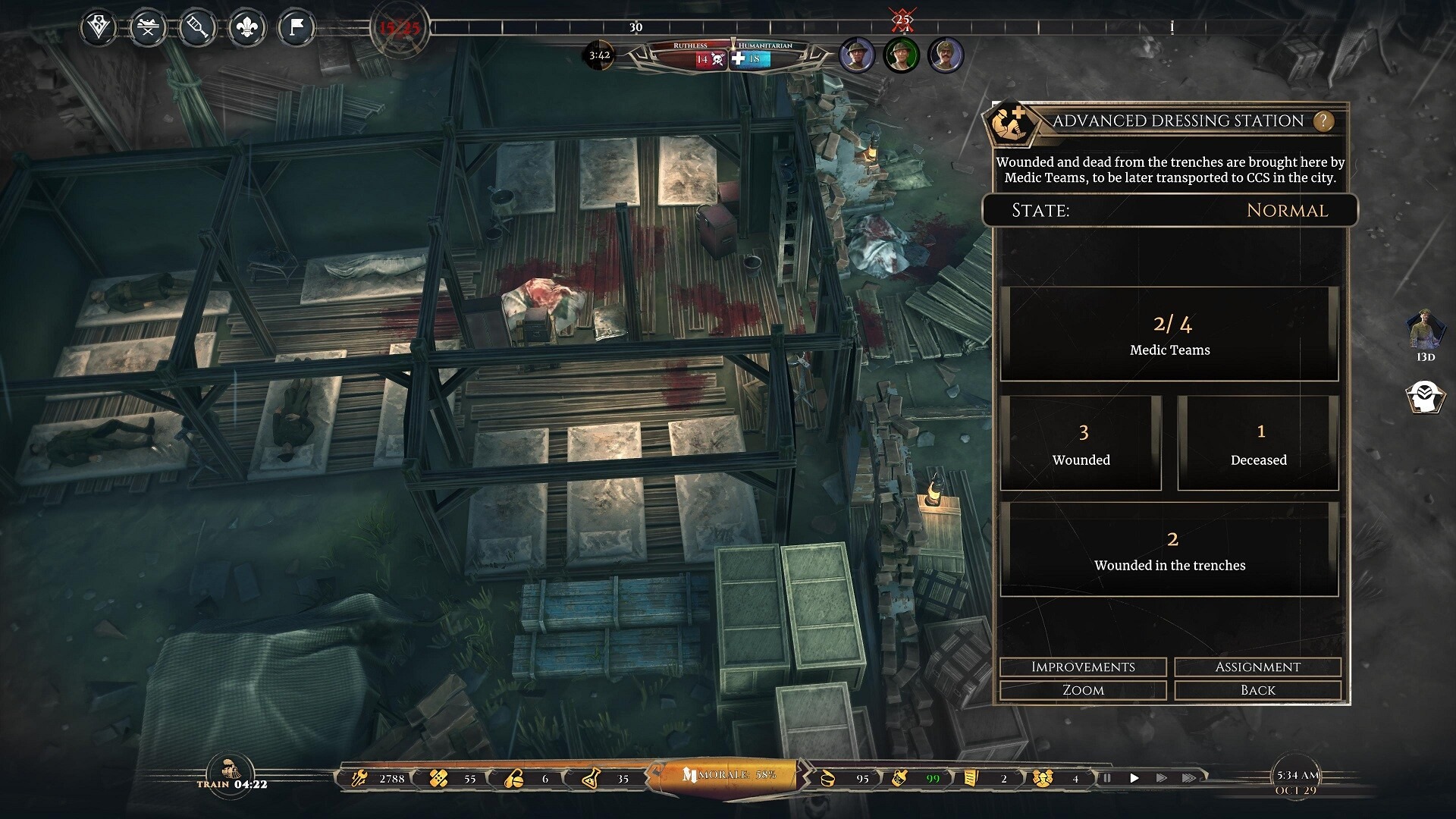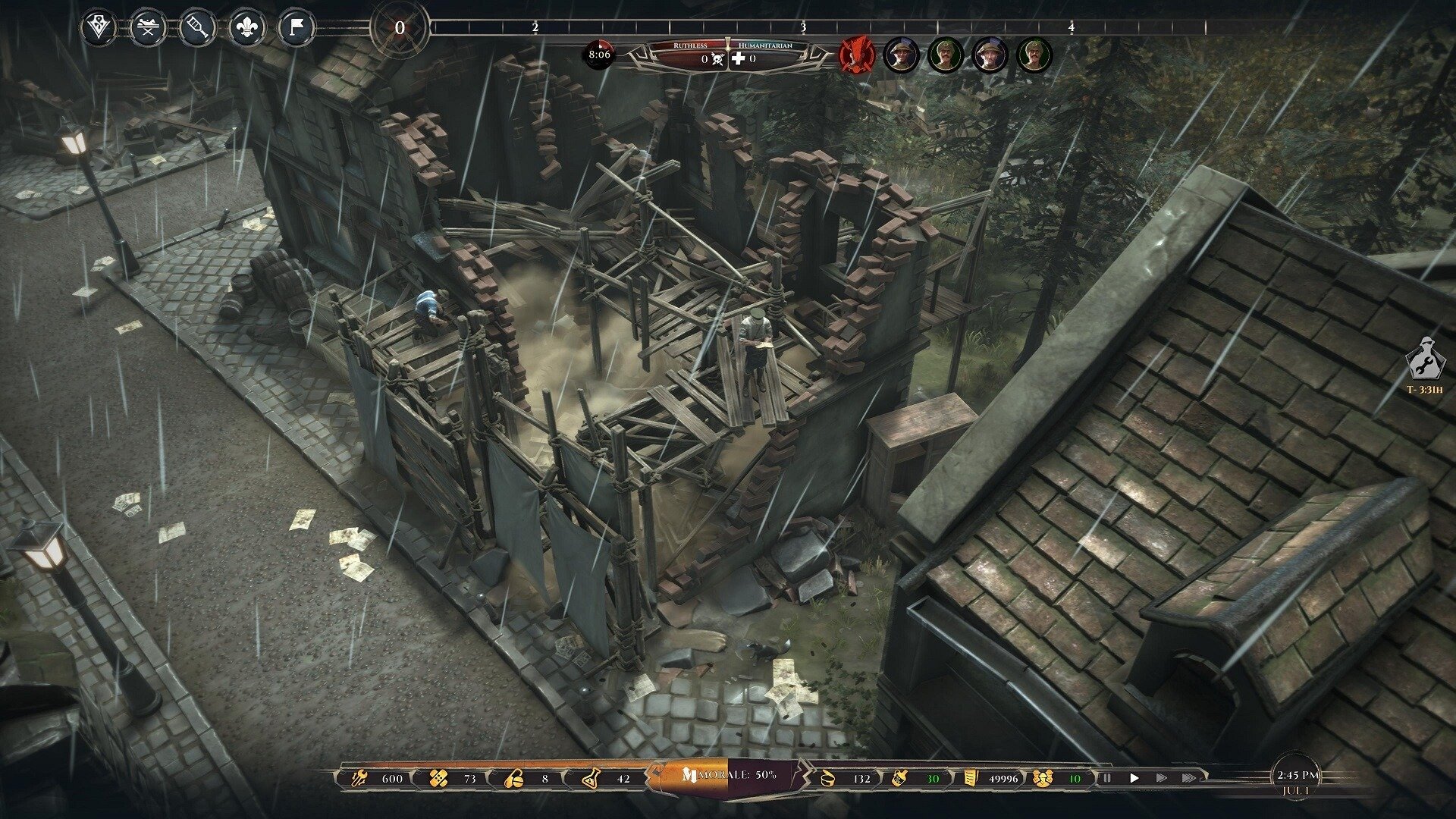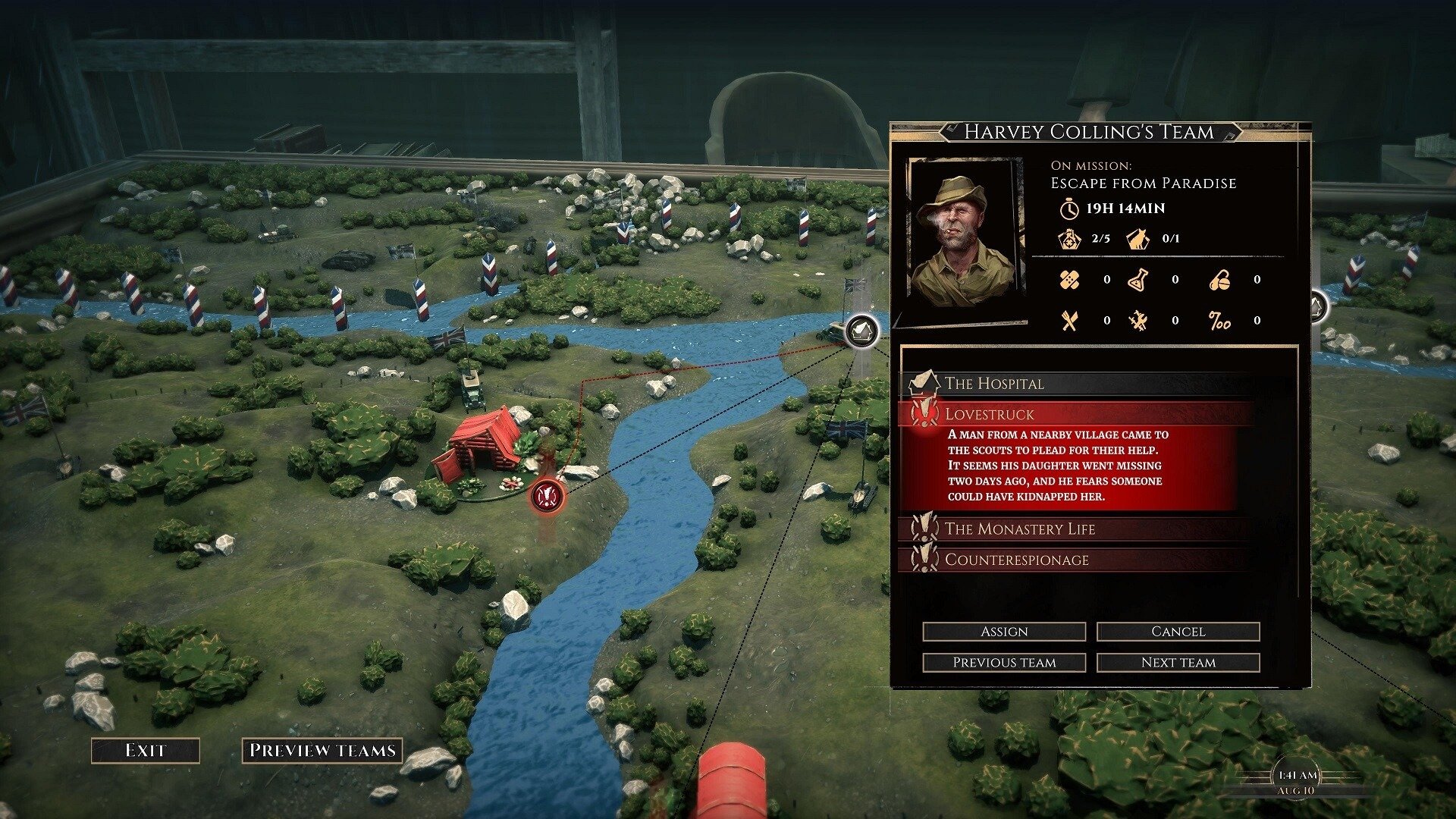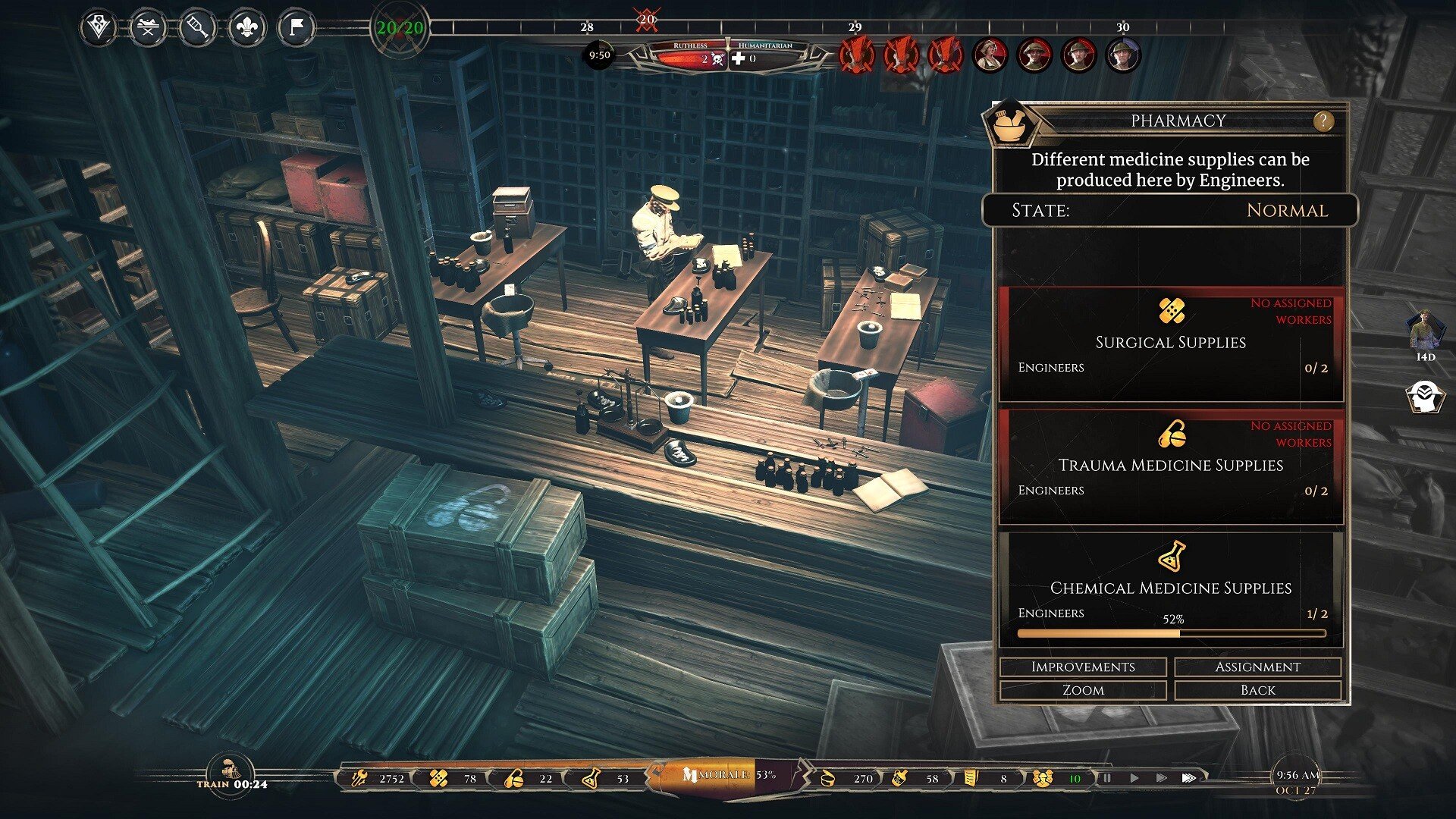For once, the video game moves away a little from the Second World War to immerse itself in the horror of the Great War (14-18) with War Hospital. This new strategic management game aims to show all the violence of the conflict, but from a completely different angle: the Army Health Service. The point of view is therefore rather daring. Not a question of seeing war with the eyes of a soldier, but rather those of a doctor. And that makes all the difference.
The First World War proved to be one of the deadliest conflicts in human history, with no less than 18 million deaths and almost 10 million directly on the battlefields. During the conflict, around 21 million men were injured by artillery or poisoned by chemical weapons. Humans have always shown boundless inventiveness in killing their neighbors, and this first world conflict was a terrible opportunity to experiment with all kinds of weapons. From flamethrowers to mustard gas and the first real machine guns, medicine therefore had to adapt directly on the ground, sometimes in quite disastrous conditions. This is what War Hospital tries as best it can to transcribe.
A hospital management game that changes
While there are already quite a few hospital management games on PC, from Two Point Hospital to Theme Hospital, War Hospital stands out by presenting itself as a strategic puzzle consisting of mobilizing staff and patients within a war-torn field hospital and sometimes a few dozen meters from the front. You play as a British doctor named Henry Wells in a campaign which is divided into 3 chapters.
Although the storyline takes a back seat for much of the game, War Hospital nevertheless depicts a fairly realistic situation that occurred on the Western Front from the British perspective. A good point if you like history. The side characters are pretty forgettable, as they only fill minor roles while occasionally giving you quests. They have just what it takes to not make you feel too alone in your complex tasks.
In fact, your main objective is to manage a hospital in wartime. Everything takes place via a top view, like the vast majority of management games. The difference is that the gameplay is rather static and takes place mainly via menus. The hospital for which you are responsible includes several typical buildings: an operating room, accommodation, a canteen, a rehabilitation center, a stock, etc. As the facility manager, you must employ staff to maintain these buildings. This is divided into doctors, nurses, medical teams, engineers and scouts. These personnel are essential to the proper functioning of your hospital, because without them, injured soldiers could die.
War Hospital gameplay is sometimes marred by bugs
A large part of the gameplay of War Hospital therefore lies in the management of this said personnel that you have employed. The number of tasks on which he can work is limited, you will have to make choices and sometimes concessions, which gives a very human side to the whole thing. Besides, note to very empathetic people, even in video games, people will die and it will be entirely your fault. If you are a little sensitive, it can quickly upset your mind a little.
Unfortunately, the game can sometimes be frustrating due to unexpected bugs and spoil this empathy. For example, medical teams and doctors sometimes stop working for no apparent reason, quickly leading to patient congestion and unnecessary deaths. These issues can have a significant impact on gameplay and spoil the enjoyment of the game. Fingers crossed that this will be resolved quickly, because the game really deserves it.
The assignment of patients to doctors and the micromanagement of the health of the doctors themselves are the most important aspects to oversee, and they constitute the heart of the gameplay and everything that will take place around it. You will assign medical teams to transport patients and bodies in and out of the operation building while engineers provide medical supplies, and while nurses help increase operation success rates . Successfully healing the wounded will make them eligible for rehabilitation, which, once completed, can allow you to assign them to defensive troops, send them to HQ to earn military drafts (important for upgrades), or dismiss them at their home. Caring can therefore have a real impact on rewards in addition to a feeling of a job well done.

More resources than in a French public hospital
As your war hospital expands, new facilities become accessible. You can also organize reconnaissance teams to search for resources to aid in your survival efforts, given that the supply lines are abysmal in this part of the front. Every now and then a train arrives with random supplies, which can either be vital necessities or something you don’t particularly need. By looking at the train timetable, you can even get an idea of what you will receive and plan accordingly. This mechanic adds a random dimension which enriches the gaming experience, it’s really intelligent.
War Hospital also features dynamic events and quests, similar to Frostpunk, to constantly maintain a level of alert in the player’s mind and prevent a routine from setting in too easily. At one point, German artillery bombarded the station, depriving the hospital of supplies for a time. And God knows, managing dwindling supplies of food and medical supplies while determining which patients have the best chance of survival is morally exhausting. But it’s a great gameplay idea.

A hospital in constant evolution
Like any self-respecting strategy or management game, War Hospital also offers progression trees. These upgrade trees depend on how much healing you have done and how many missions you have completed. Hospital improvements are broken down into four categories: Healing, Housing, Production, and Reconnaissance. Initially, there tends to be a primary focus on the healing and production trees, as they offer upgrades that increase the overall efficiency of the hospital, reducing the time needed to create new resources or complete operations.
However, it would be a shame to neglect the reconnaissance tree, which unlocks after a certain time in the game and allows you to carry out missions in the surroundings of the hospital. By upgrading this tree, players can increase the number of teams available and reduce the time required to complete certain tasks. Reconnaissance missions are therefore a great way to obtain additional personnel and upgrades. With it, you can strengthen the existing workforce and their facilities significantly.

War Hospital is a bit of a mess visually speaking
Unfortunately, to manage all of this, you have to deal with the overall rigidity of the menus. Instead of simply offering a smooth interface, the game seems rather outdated, or even completely outdated in certain aspects. For example, upon release, there were no keyboard shortcuts for accessing menus, forcing players to laboriously move their cursor over each one at the top left of the screen. A shame for a production of 2024.
Fortunately, a patch finally arrived quite quickly after complaints from players on the forums. The studio seems responsive, so much the better. However, even after the patch, the interface remains quite outdated and above all very rigid. It’s easy to get lost and it’s not really possible to move the different windows. The game is also not a model in terms of technique and it struggles to pay homage to the historical details that litter War Hospital, such as the operating tables for example.
Rest assured, it’s not a disaster, but we clearly feel that the interface, and more generally the graphic aspect, have been relegated to the background. Visually, it’s pretty average. Fortunately, to counter the very static aspect of the game, it is possible to zoom in slightly on the buildings to observe what is happening in your military hospital. This brings a little life and modernity to the whole.
But don’t expect a game full of life like Two Point Hospital where there is always something to observe. That is not the case here. But the zoom still allows you to add an additional dimension to the simulation and creates a feeling of immersion which ultimately works quite well. If we add to this the good gameplay ideas and the very human side of the theme, we obtain a fairly extraordinary management game, transcending the usual genres. It falls somewhere between Frostpunk, Theme Hospital and The Great War Western Front.

